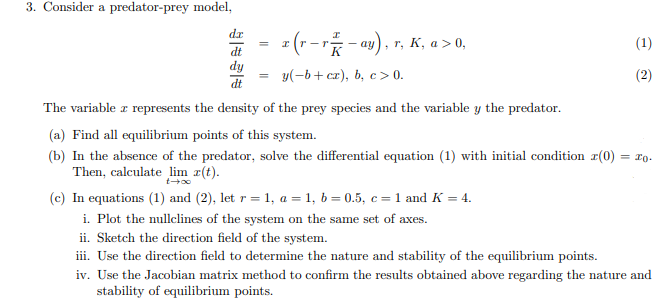3. Consider a predator-prey model, z (r-ray), r r, K, a>0, (1) y(-b+cz), b, c> 0. (2) The variable z represents the density of the prey species and the variable y the predator. (a) Find all equilibrium points of this system. (b) In the absence of the predator, solve the differential equation (1) with initial condition z(0) = Io- Then, calculate lim z(t). (c) In equations (1) and (2), let r=1, a = 1, b=0.5, c = 1 and K = 4. i. Plot the nullclines of the system on the same set of axes. ii. Sketch the direction field of the system. iii. Use the direction field to determine the nature and stability of the equilibrium points. iv. Use the Jacobian matrix method to confirm the results obtained above regarding the nature and stability of equilibrium points. 004-7
3. Consider a predator-prey model, z (r-ray), r r, K, a>0, (1) y(-b+cz), b, c> 0. (2) The variable z represents the density of the prey species and the variable y the predator. (a) Find all equilibrium points of this system. (b) In the absence of the predator, solve the differential equation (1) with initial condition z(0) = Io- Then, calculate lim z(t). (c) In equations (1) and (2), let r=1, a = 1, b=0.5, c = 1 and K = 4. i. Plot the nullclines of the system on the same set of axes. ii. Sketch the direction field of the system. iii. Use the direction field to determine the nature and stability of the equilibrium points. iv. Use the Jacobian matrix method to confirm the results obtained above regarding the nature and stability of equilibrium points. 004-7
Advanced Engineering Mathematics
10th Edition
ISBN:9780470458365
Author:Erwin Kreyszig
Publisher:Erwin Kreyszig
Chapter2: Second-order Linear Odes
Section: Chapter Questions
Problem 1RQ
Related questions
Question
PLEASE HELP WITH THIS QUESTION

Transcribed Image Text:3. Consider a predator-prey model,
dr
=
x (r - r ² − ay), r, K, a > 0,
(1)
dt
dy
=
y(-b+cz), b, c> 0.
(2)
dt
The variable z represents the density of the prey species and the variable y the predator.
I
(a) Find all equilibrium points of this system.
= 10.
(b) In the absence of the predator, solve the differential equation (1) with initial condition z(0)
Then, calculate lim z(t).
(c) In equations (1) and (2), let r = 1, a = 1, b=0.5, c = 1 and K = 4.
i. Plot the nullclines of the system on the same set of axes.
ii. Sketch the direction field of the system.
iii. Use the direction field to determine the nature and stability of the equilibrium points.
iv. Use the Jacobian matrix method to confirm the results obtained above regarding the nature and
stability of equilibrium points.
| |
Expert Solution
This question has been solved!
Explore an expertly crafted, step-by-step solution for a thorough understanding of key concepts.
Step by step
Solved in 8 steps with 5 images

Recommended textbooks for you

Advanced Engineering Mathematics
Advanced Math
ISBN:
9780470458365
Author:
Erwin Kreyszig
Publisher:
Wiley, John & Sons, Incorporated

Numerical Methods for Engineers
Advanced Math
ISBN:
9780073397924
Author:
Steven C. Chapra Dr., Raymond P. Canale
Publisher:
McGraw-Hill Education

Introductory Mathematics for Engineering Applicat…
Advanced Math
ISBN:
9781118141809
Author:
Nathan Klingbeil
Publisher:
WILEY

Advanced Engineering Mathematics
Advanced Math
ISBN:
9780470458365
Author:
Erwin Kreyszig
Publisher:
Wiley, John & Sons, Incorporated

Numerical Methods for Engineers
Advanced Math
ISBN:
9780073397924
Author:
Steven C. Chapra Dr., Raymond P. Canale
Publisher:
McGraw-Hill Education

Introductory Mathematics for Engineering Applicat…
Advanced Math
ISBN:
9781118141809
Author:
Nathan Klingbeil
Publisher:
WILEY

Mathematics For Machine Technology
Advanced Math
ISBN:
9781337798310
Author:
Peterson, John.
Publisher:
Cengage Learning,

